Factors Influencing Adult Obesity and Treatment Strategies in England
VerifiedAdded on 2023/06/12
|41
|14630
|291
Essay
AI Summary
This essay examines the factors contributing to adult obesity in England and the various treatment strategies employed to combat this public health issue. It highlights the alarming rise in obesity rates, the associated health risks such as hypertension, diabetes, and cancer, and the significant economic burden on the NHS. The essay delves into lifestyle factors like sedentary behaviors and energy-dense food consumption, as well as cultural influences, genetic predispositions, and the impact of an obesogenic environment. It also discusses the role of ethnicity and perception of overweight in shaping individual behaviors. Furthermore, the essay touches upon potential interventions, including pharmaceutical and surgical options, policy recommendations for healthier food environments, and public health campaigns promoting healthy lifestyles. The analysis underscores the complexities of obesity and the need for comprehensive strategies to address this growing concern.

The factors that cause adult obesity in England and the strategies of treating the condition
Name
University
Name
University
Paraphrase This Document
Need a fresh take? Get an instant paraphrase of this document with our AI Paraphraser
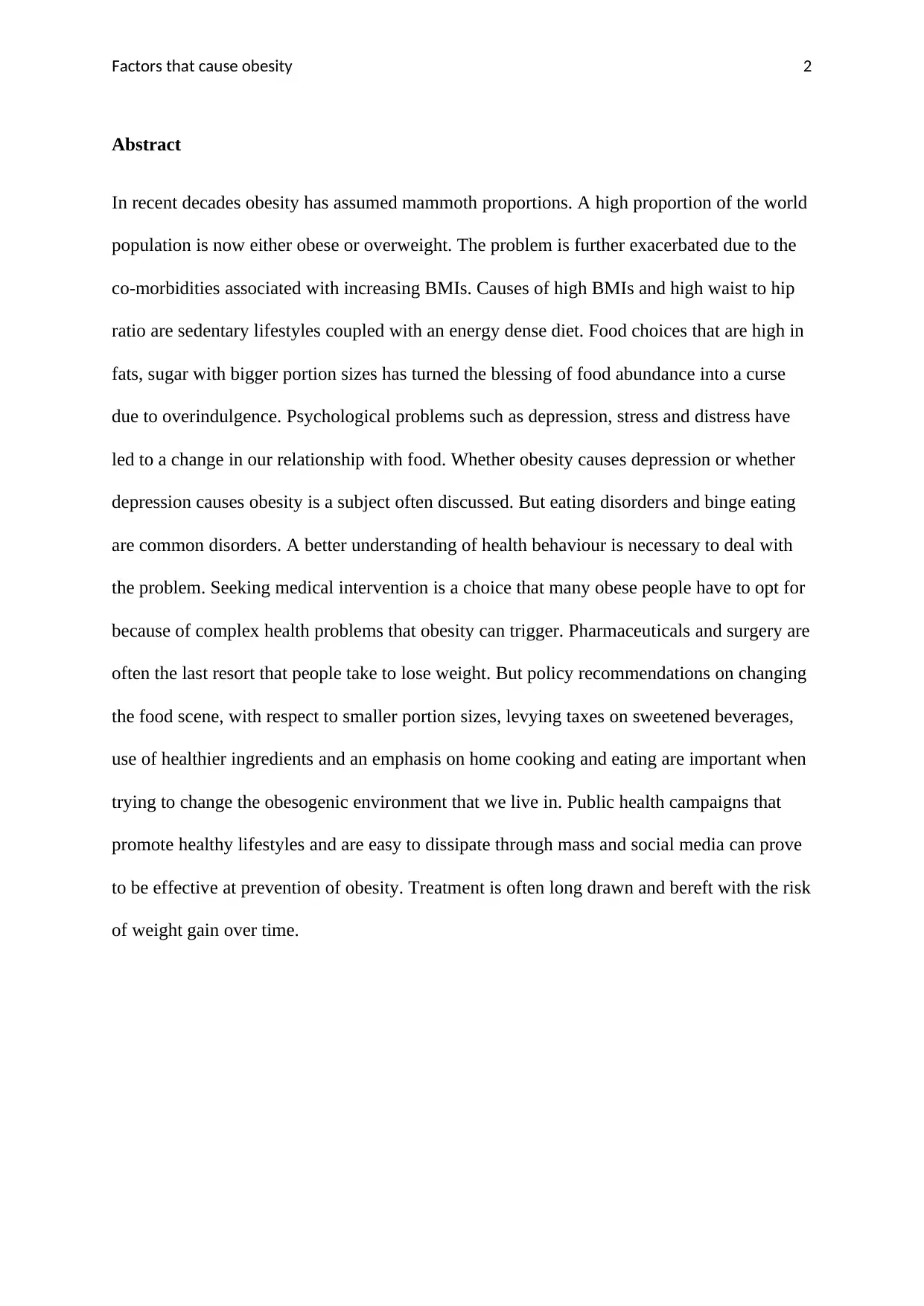
Factors that cause obesity 2
Abstract
In recent decades obesity has assumed mammoth proportions. A high proportion of the world
population is now either obese or overweight. The problem is further exacerbated due to the
co-morbidities associated with increasing BMIs. Causes of high BMIs and high waist to hip
ratio are sedentary lifestyles coupled with an energy dense diet. Food choices that are high in
fats, sugar with bigger portion sizes has turned the blessing of food abundance into a curse
due to overindulgence. Psychological problems such as depression, stress and distress have
led to a change in our relationship with food. Whether obesity causes depression or whether
depression causes obesity is a subject often discussed. But eating disorders and binge eating
are common disorders. A better understanding of health behaviour is necessary to deal with
the problem. Seeking medical intervention is a choice that many obese people have to opt for
because of complex health problems that obesity can trigger. Pharmaceuticals and surgery are
often the last resort that people take to lose weight. But policy recommendations on changing
the food scene, with respect to smaller portion sizes, levying taxes on sweetened beverages,
use of healthier ingredients and an emphasis on home cooking and eating are important when
trying to change the obesogenic environment that we live in. Public health campaigns that
promote healthy lifestyles and are easy to dissipate through mass and social media can prove
to be effective at prevention of obesity. Treatment is often long drawn and bereft with the risk
of weight gain over time.
Abstract
In recent decades obesity has assumed mammoth proportions. A high proportion of the world
population is now either obese or overweight. The problem is further exacerbated due to the
co-morbidities associated with increasing BMIs. Causes of high BMIs and high waist to hip
ratio are sedentary lifestyles coupled with an energy dense diet. Food choices that are high in
fats, sugar with bigger portion sizes has turned the blessing of food abundance into a curse
due to overindulgence. Psychological problems such as depression, stress and distress have
led to a change in our relationship with food. Whether obesity causes depression or whether
depression causes obesity is a subject often discussed. But eating disorders and binge eating
are common disorders. A better understanding of health behaviour is necessary to deal with
the problem. Seeking medical intervention is a choice that many obese people have to opt for
because of complex health problems that obesity can trigger. Pharmaceuticals and surgery are
often the last resort that people take to lose weight. But policy recommendations on changing
the food scene, with respect to smaller portion sizes, levying taxes on sweetened beverages,
use of healthier ingredients and an emphasis on home cooking and eating are important when
trying to change the obesogenic environment that we live in. Public health campaigns that
promote healthy lifestyles and are easy to dissipate through mass and social media can prove
to be effective at prevention of obesity. Treatment is often long drawn and bereft with the risk
of weight gain over time.

Factors that cause obesity 3
Introduction.......................................................................................................................................4
Chapter 1...........................................................................................................................................7
Chapter 2.........................................................................................................................................16
Chapter-3.........................................................................................................................................24
Conclusion.......................................................................................................................................33
References.......................................................................................................................................35
Introduction.......................................................................................................................................4
Chapter 1...........................................................................................................................................7
Chapter 2.........................................................................................................................................16
Chapter-3.........................................................................................................................................24
Conclusion.......................................................................................................................................33
References.......................................................................................................................................35
⊘ This is a preview!⊘
Do you want full access?
Subscribe today to unlock all pages.

Trusted by 1+ million students worldwide
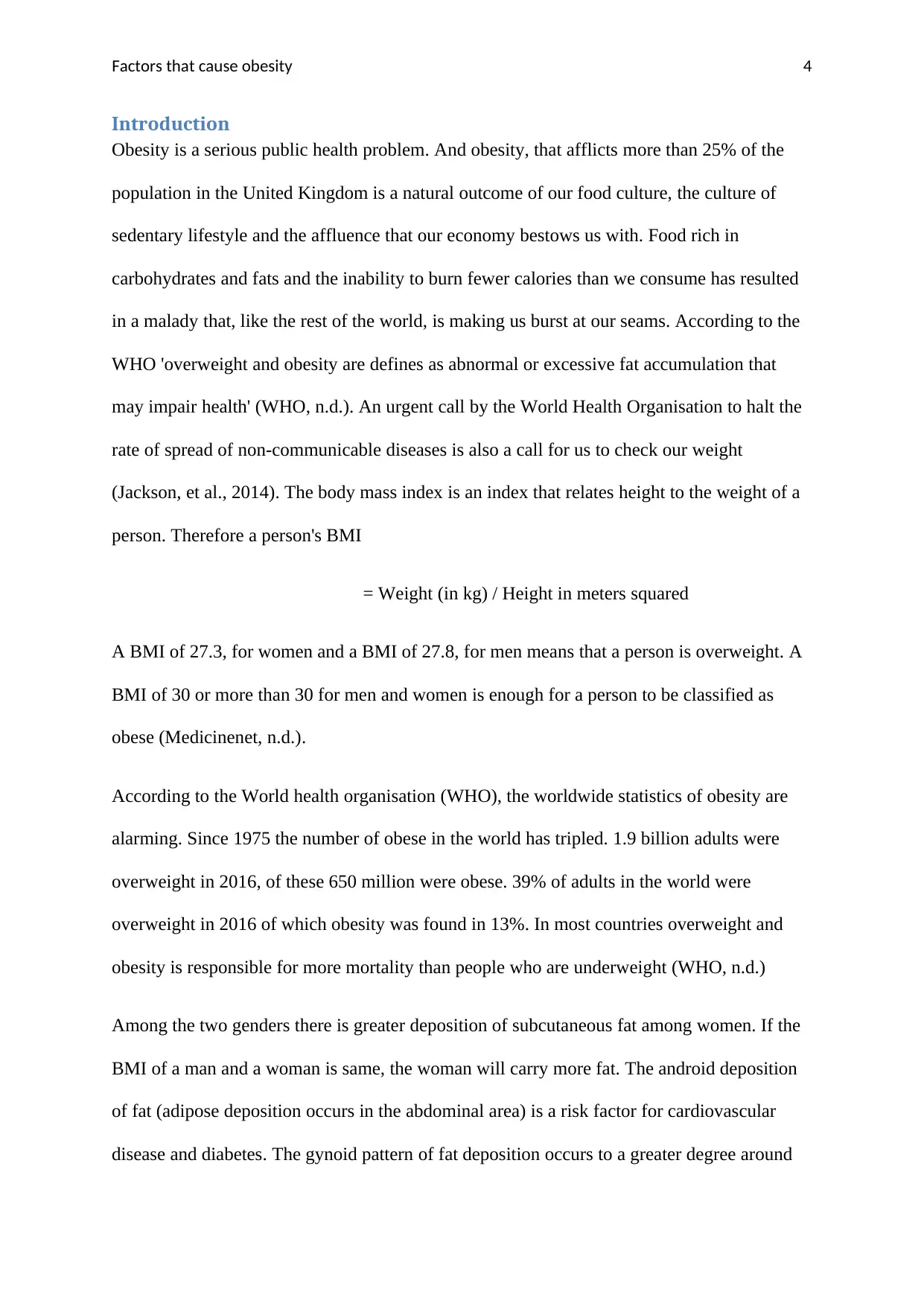
Factors that cause obesity 4
Introduction
Obesity is a serious public health problem. And obesity, that afflicts more than 25% of the
population in the United Kingdom is a natural outcome of our food culture, the culture of
sedentary lifestyle and the affluence that our economy bestows us with. Food rich in
carbohydrates and fats and the inability to burn fewer calories than we consume has resulted
in a malady that, like the rest of the world, is making us burst at our seams. According to the
WHO 'overweight and obesity are defines as abnormal or excessive fat accumulation that
may impair health' (WHO, n.d.). An urgent call by the World Health Organisation to halt the
rate of spread of non-communicable diseases is also a call for us to check our weight
(Jackson, et al., 2014). The body mass index is an index that relates height to the weight of a
person. Therefore a person's BMI
= Weight (in kg) / Height in meters squared
A BMI of 27.3, for women and a BMI of 27.8, for men means that a person is overweight. A
BMI of 30 or more than 30 for men and women is enough for a person to be classified as
obese (Medicinenet, n.d.).
According to the World health organisation (WHO), the worldwide statistics of obesity are
alarming. Since 1975 the number of obese in the world has tripled. 1.9 billion adults were
overweight in 2016, of these 650 million were obese. 39% of adults in the world were
overweight in 2016 of which obesity was found in 13%. In most countries overweight and
obesity is responsible for more mortality than people who are underweight (WHO, n.d.)
Among the two genders there is greater deposition of subcutaneous fat among women. If the
BMI of a man and a woman is same, the woman will carry more fat. The android deposition
of fat (adipose deposition occurs in the abdominal area) is a risk factor for cardiovascular
disease and diabetes. The gynoid pattern of fat deposition occurs to a greater degree around
Introduction
Obesity is a serious public health problem. And obesity, that afflicts more than 25% of the
population in the United Kingdom is a natural outcome of our food culture, the culture of
sedentary lifestyle and the affluence that our economy bestows us with. Food rich in
carbohydrates and fats and the inability to burn fewer calories than we consume has resulted
in a malady that, like the rest of the world, is making us burst at our seams. According to the
WHO 'overweight and obesity are defines as abnormal or excessive fat accumulation that
may impair health' (WHO, n.d.). An urgent call by the World Health Organisation to halt the
rate of spread of non-communicable diseases is also a call for us to check our weight
(Jackson, et al., 2014). The body mass index is an index that relates height to the weight of a
person. Therefore a person's BMI
= Weight (in kg) / Height in meters squared
A BMI of 27.3, for women and a BMI of 27.8, for men means that a person is overweight. A
BMI of 30 or more than 30 for men and women is enough for a person to be classified as
obese (Medicinenet, n.d.).
According to the World health organisation (WHO), the worldwide statistics of obesity are
alarming. Since 1975 the number of obese in the world has tripled. 1.9 billion adults were
overweight in 2016, of these 650 million were obese. 39% of adults in the world were
overweight in 2016 of which obesity was found in 13%. In most countries overweight and
obesity is responsible for more mortality than people who are underweight (WHO, n.d.)
Among the two genders there is greater deposition of subcutaneous fat among women. If the
BMI of a man and a woman is same, the woman will carry more fat. The android deposition
of fat (adipose deposition occurs in the abdominal area) is a risk factor for cardiovascular
disease and diabetes. The gynoid pattern of fat deposition occurs to a greater degree around
Paraphrase This Document
Need a fresh take? Get an instant paraphrase of this document with our AI Paraphraser
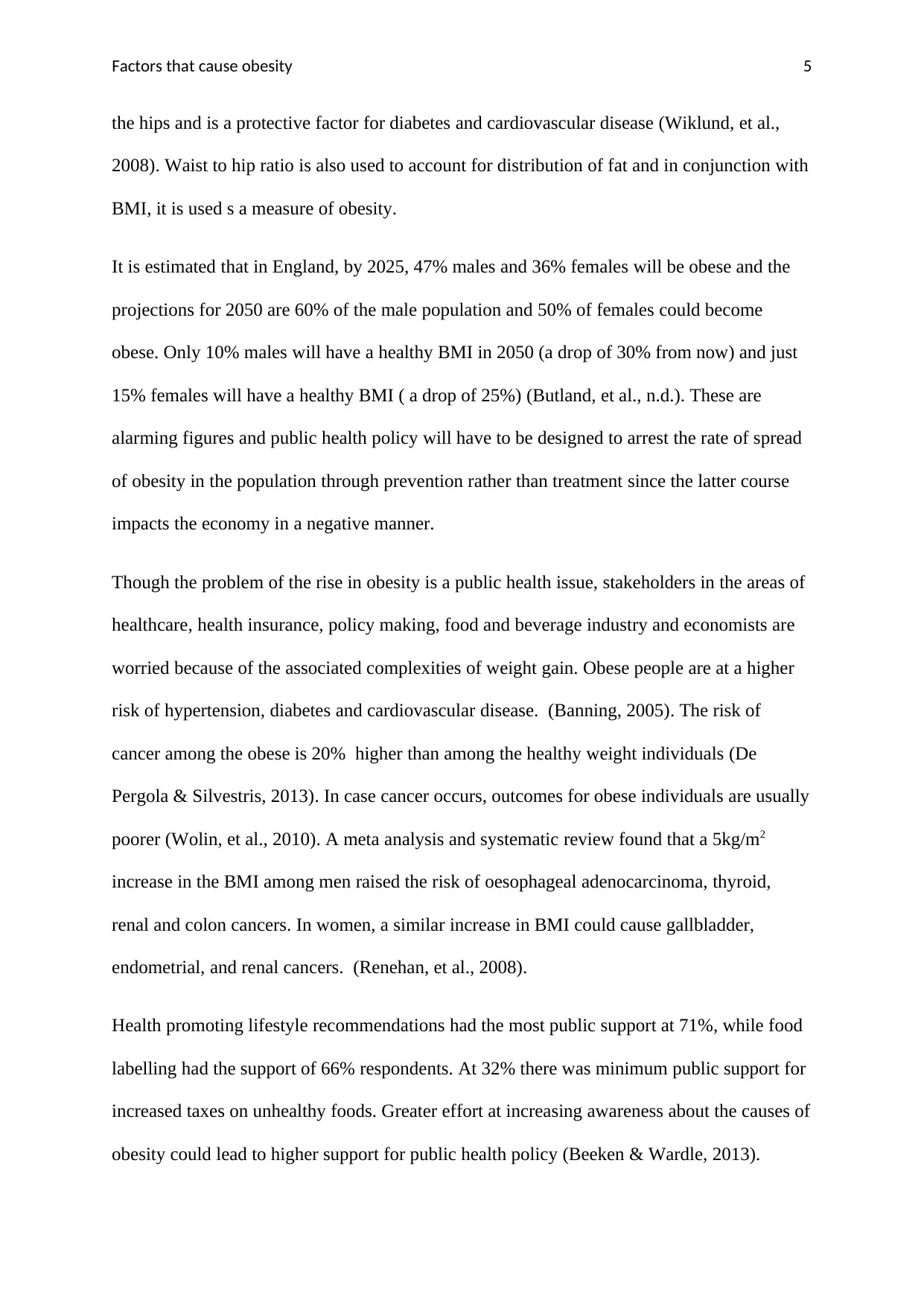
Factors that cause obesity 5
the hips and is a protective factor for diabetes and cardiovascular disease (Wiklund, et al.,
2008). Waist to hip ratio is also used to account for distribution of fat and in conjunction with
BMI, it is used s a measure of obesity.
It is estimated that in England, by 2025, 47% males and 36% females will be obese and the
projections for 2050 are 60% of the male population and 50% of females could become
obese. Only 10% males will have a healthy BMI in 2050 (a drop of 30% from now) and just
15% females will have a healthy BMI ( a drop of 25%) (Butland, et al., n.d.). These are
alarming figures and public health policy will have to be designed to arrest the rate of spread
of obesity in the population through prevention rather than treatment since the latter course
impacts the economy in a negative manner.
Though the problem of the rise in obesity is a public health issue, stakeholders in the areas of
healthcare, health insurance, policy making, food and beverage industry and economists are
worried because of the associated complexities of weight gain. Obese people are at a higher
risk of hypertension, diabetes and cardiovascular disease. (Banning, 2005). The risk of
cancer among the obese is 20% higher than among the healthy weight individuals (De
Pergola & Silvestris, 2013). In case cancer occurs, outcomes for obese individuals are usually
poorer (Wolin, et al., 2010). A meta analysis and systematic review found that a 5kg/m2
increase in the BMI among men raised the risk of oesophageal adenocarcinoma, thyroid,
renal and colon cancers. In women, a similar increase in BMI could cause gallbladder,
endometrial, and renal cancers. (Renehan, et al., 2008).
Health promoting lifestyle recommendations had the most public support at 71%, while food
labelling had the support of 66% respondents. At 32% there was minimum public support for
increased taxes on unhealthy foods. Greater effort at increasing awareness about the causes of
obesity could lead to higher support for public health policy (Beeken & Wardle, 2013).
the hips and is a protective factor for diabetes and cardiovascular disease (Wiklund, et al.,
2008). Waist to hip ratio is also used to account for distribution of fat and in conjunction with
BMI, it is used s a measure of obesity.
It is estimated that in England, by 2025, 47% males and 36% females will be obese and the
projections for 2050 are 60% of the male population and 50% of females could become
obese. Only 10% males will have a healthy BMI in 2050 (a drop of 30% from now) and just
15% females will have a healthy BMI ( a drop of 25%) (Butland, et al., n.d.). These are
alarming figures and public health policy will have to be designed to arrest the rate of spread
of obesity in the population through prevention rather than treatment since the latter course
impacts the economy in a negative manner.
Though the problem of the rise in obesity is a public health issue, stakeholders in the areas of
healthcare, health insurance, policy making, food and beverage industry and economists are
worried because of the associated complexities of weight gain. Obese people are at a higher
risk of hypertension, diabetes and cardiovascular disease. (Banning, 2005). The risk of
cancer among the obese is 20% higher than among the healthy weight individuals (De
Pergola & Silvestris, 2013). In case cancer occurs, outcomes for obese individuals are usually
poorer (Wolin, et al., 2010). A meta analysis and systematic review found that a 5kg/m2
increase in the BMI among men raised the risk of oesophageal adenocarcinoma, thyroid,
renal and colon cancers. In women, a similar increase in BMI could cause gallbladder,
endometrial, and renal cancers. (Renehan, et al., 2008).
Health promoting lifestyle recommendations had the most public support at 71%, while food
labelling had the support of 66% respondents. At 32% there was minimum public support for
increased taxes on unhealthy foods. Greater effort at increasing awareness about the causes of
obesity could lead to higher support for public health policy (Beeken & Wardle, 2013).
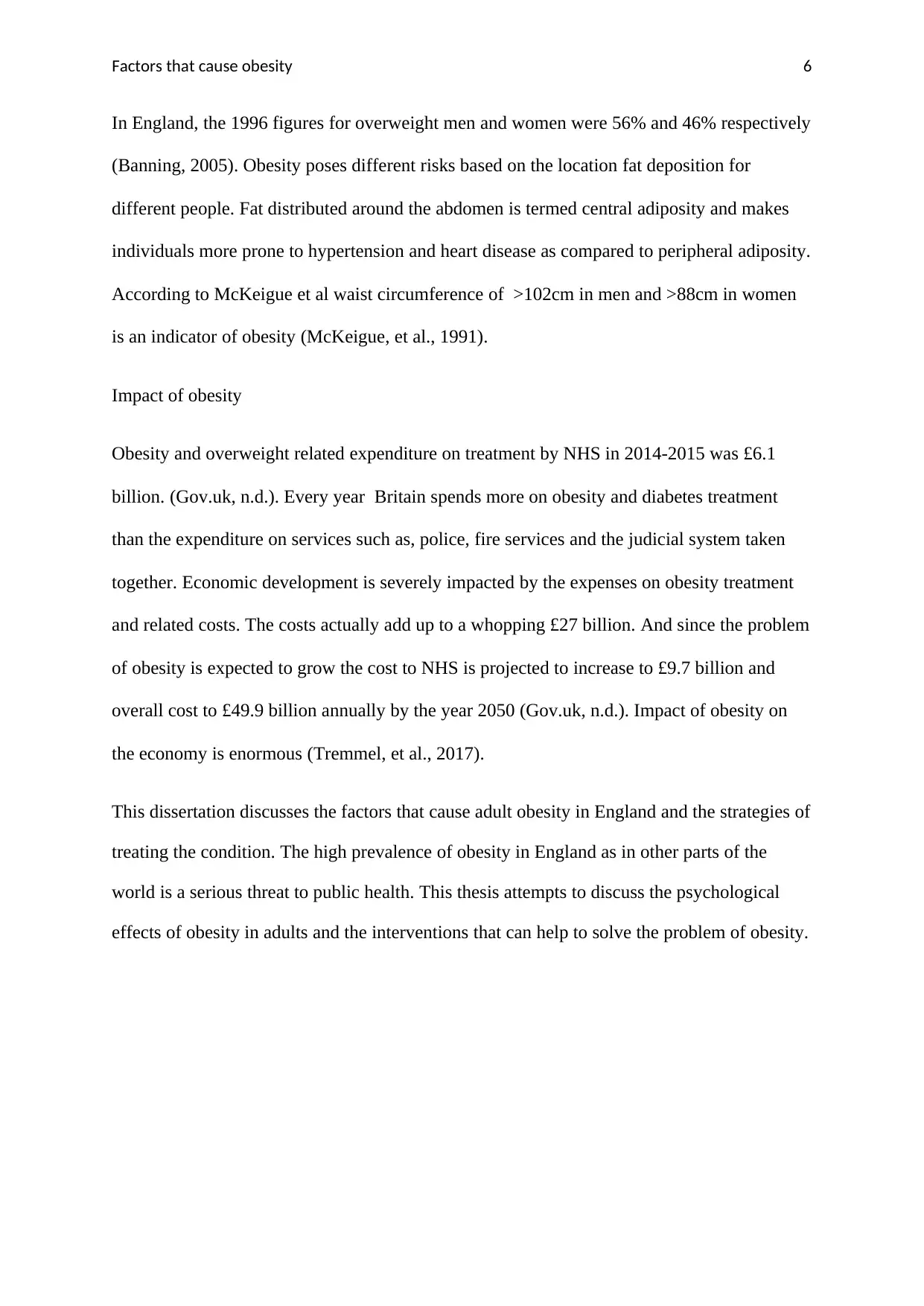
Factors that cause obesity 6
In England, the 1996 figures for overweight men and women were 56% and 46% respectively
(Banning, 2005). Obesity poses different risks based on the location fat deposition for
different people. Fat distributed around the abdomen is termed central adiposity and makes
individuals more prone to hypertension and heart disease as compared to peripheral adiposity.
According to McKeigue et al waist circumference of ˃102cm in men and ˃88cm in women
is an indicator of obesity (McKeigue, et al., 1991).
Impact of obesity
Obesity and overweight related expenditure on treatment by NHS in 2014-2015 was £6.1
billion. (Gov.uk, n.d.). Every year Britain spends more on obesity and diabetes treatment
than the expenditure on services such as, police, fire services and the judicial system taken
together. Economic development is severely impacted by the expenses on obesity treatment
and related costs. The costs actually add up to a whopping £27 billion. And since the problem
of obesity is expected to grow the cost to NHS is projected to increase to £9.7 billion and
overall cost to £49.9 billion annually by the year 2050 (Gov.uk, n.d.). Impact of obesity on
the economy is enormous (Tremmel, et al., 2017).
This dissertation discusses the factors that cause adult obesity in England and the strategies of
treating the condition. The high prevalence of obesity in England as in other parts of the
world is a serious threat to public health. This thesis attempts to discuss the psychological
effects of obesity in adults and the interventions that can help to solve the problem of obesity.
In England, the 1996 figures for overweight men and women were 56% and 46% respectively
(Banning, 2005). Obesity poses different risks based on the location fat deposition for
different people. Fat distributed around the abdomen is termed central adiposity and makes
individuals more prone to hypertension and heart disease as compared to peripheral adiposity.
According to McKeigue et al waist circumference of ˃102cm in men and ˃88cm in women
is an indicator of obesity (McKeigue, et al., 1991).
Impact of obesity
Obesity and overweight related expenditure on treatment by NHS in 2014-2015 was £6.1
billion. (Gov.uk, n.d.). Every year Britain spends more on obesity and diabetes treatment
than the expenditure on services such as, police, fire services and the judicial system taken
together. Economic development is severely impacted by the expenses on obesity treatment
and related costs. The costs actually add up to a whopping £27 billion. And since the problem
of obesity is expected to grow the cost to NHS is projected to increase to £9.7 billion and
overall cost to £49.9 billion annually by the year 2050 (Gov.uk, n.d.). Impact of obesity on
the economy is enormous (Tremmel, et al., 2017).
This dissertation discusses the factors that cause adult obesity in England and the strategies of
treating the condition. The high prevalence of obesity in England as in other parts of the
world is a serious threat to public health. This thesis attempts to discuss the psychological
effects of obesity in adults and the interventions that can help to solve the problem of obesity.
⊘ This is a preview!⊘
Do you want full access?
Subscribe today to unlock all pages.

Trusted by 1+ million students worldwide
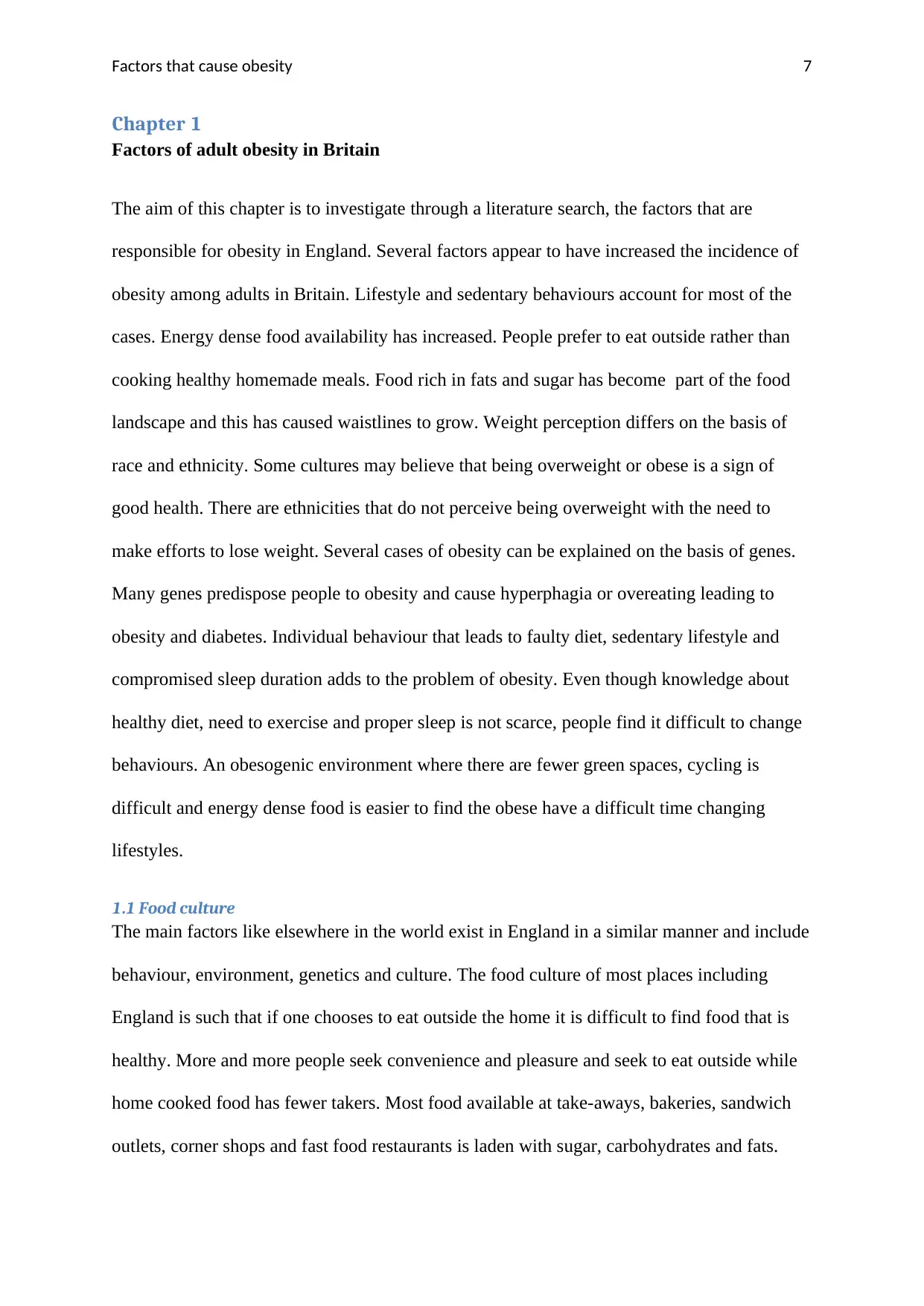
Factors that cause obesity 7
Chapter 1
Factors of adult obesity in Britain
The aim of this chapter is to investigate through a literature search, the factors that are
responsible for obesity in England. Several factors appear to have increased the incidence of
obesity among adults in Britain. Lifestyle and sedentary behaviours account for most of the
cases. Energy dense food availability has increased. People prefer to eat outside rather than
cooking healthy homemade meals. Food rich in fats and sugar has become part of the food
landscape and this has caused waistlines to grow. Weight perception differs on the basis of
race and ethnicity. Some cultures may believe that being overweight or obese is a sign of
good health. There are ethnicities that do not perceive being overweight with the need to
make efforts to lose weight. Several cases of obesity can be explained on the basis of genes.
Many genes predispose people to obesity and cause hyperphagia or overeating leading to
obesity and diabetes. Individual behaviour that leads to faulty diet, sedentary lifestyle and
compromised sleep duration adds to the problem of obesity. Even though knowledge about
healthy diet, need to exercise and proper sleep is not scarce, people find it difficult to change
behaviours. An obesogenic environment where there are fewer green spaces, cycling is
difficult and energy dense food is easier to find the obese have a difficult time changing
lifestyles.
1.1 Food culture
The main factors like elsewhere in the world exist in England in a similar manner and include
behaviour, environment, genetics and culture. The food culture of most places including
England is such that if one chooses to eat outside the home it is difficult to find food that is
healthy. More and more people seek convenience and pleasure and seek to eat outside while
home cooked food has fewer takers. Most food available at take-aways, bakeries, sandwich
outlets, corner shops and fast food restaurants is laden with sugar, carbohydrates and fats.
Chapter 1
Factors of adult obesity in Britain
The aim of this chapter is to investigate through a literature search, the factors that are
responsible for obesity in England. Several factors appear to have increased the incidence of
obesity among adults in Britain. Lifestyle and sedentary behaviours account for most of the
cases. Energy dense food availability has increased. People prefer to eat outside rather than
cooking healthy homemade meals. Food rich in fats and sugar has become part of the food
landscape and this has caused waistlines to grow. Weight perception differs on the basis of
race and ethnicity. Some cultures may believe that being overweight or obese is a sign of
good health. There are ethnicities that do not perceive being overweight with the need to
make efforts to lose weight. Several cases of obesity can be explained on the basis of genes.
Many genes predispose people to obesity and cause hyperphagia or overeating leading to
obesity and diabetes. Individual behaviour that leads to faulty diet, sedentary lifestyle and
compromised sleep duration adds to the problem of obesity. Even though knowledge about
healthy diet, need to exercise and proper sleep is not scarce, people find it difficult to change
behaviours. An obesogenic environment where there are fewer green spaces, cycling is
difficult and energy dense food is easier to find the obese have a difficult time changing
lifestyles.
1.1 Food culture
The main factors like elsewhere in the world exist in England in a similar manner and include
behaviour, environment, genetics and culture. The food culture of most places including
England is such that if one chooses to eat outside the home it is difficult to find food that is
healthy. More and more people seek convenience and pleasure and seek to eat outside while
home cooked food has fewer takers. Most food available at take-aways, bakeries, sandwich
outlets, corner shops and fast food restaurants is laden with sugar, carbohydrates and fats.
Paraphrase This Document
Need a fresh take? Get an instant paraphrase of this document with our AI Paraphraser
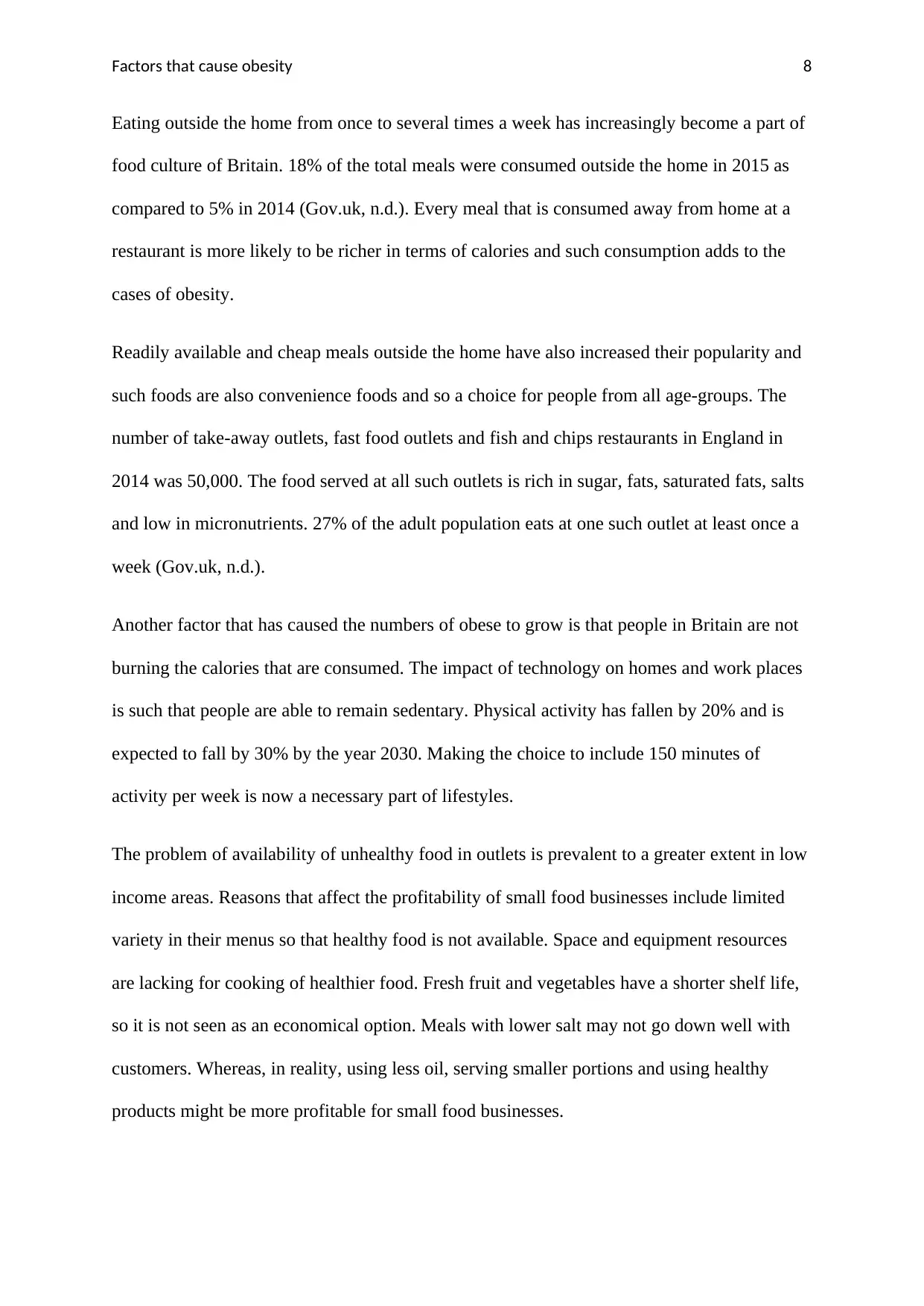
Factors that cause obesity 8
Eating outside the home from once to several times a week has increasingly become a part of
food culture of Britain. 18% of the total meals were consumed outside the home in 2015 as
compared to 5% in 2014 (Gov.uk, n.d.). Every meal that is consumed away from home at a
restaurant is more likely to be richer in terms of calories and such consumption adds to the
cases of obesity.
Readily available and cheap meals outside the home have also increased their popularity and
such foods are also convenience foods and so a choice for people from all age-groups. The
number of take-away outlets, fast food outlets and fish and chips restaurants in England in
2014 was 50,000. The food served at all such outlets is rich in sugar, fats, saturated fats, salts
and low in micronutrients. 27% of the adult population eats at one such outlet at least once a
week (Gov.uk, n.d.).
Another factor that has caused the numbers of obese to grow is that people in Britain are not
burning the calories that are consumed. The impact of technology on homes and work places
is such that people are able to remain sedentary. Physical activity has fallen by 20% and is
expected to fall by 30% by the year 2030. Making the choice to include 150 minutes of
activity per week is now a necessary part of lifestyles.
The problem of availability of unhealthy food in outlets is prevalent to a greater extent in low
income areas. Reasons that affect the profitability of small food businesses include limited
variety in their menus so that healthy food is not available. Space and equipment resources
are lacking for cooking of healthier food. Fresh fruit and vegetables have a shorter shelf life,
so it is not seen as an economical option. Meals with lower salt may not go down well with
customers. Whereas, in reality, using less oil, serving smaller portions and using healthy
products might be more profitable for small food businesses.
Eating outside the home from once to several times a week has increasingly become a part of
food culture of Britain. 18% of the total meals were consumed outside the home in 2015 as
compared to 5% in 2014 (Gov.uk, n.d.). Every meal that is consumed away from home at a
restaurant is more likely to be richer in terms of calories and such consumption adds to the
cases of obesity.
Readily available and cheap meals outside the home have also increased their popularity and
such foods are also convenience foods and so a choice for people from all age-groups. The
number of take-away outlets, fast food outlets and fish and chips restaurants in England in
2014 was 50,000. The food served at all such outlets is rich in sugar, fats, saturated fats, salts
and low in micronutrients. 27% of the adult population eats at one such outlet at least once a
week (Gov.uk, n.d.).
Another factor that has caused the numbers of obese to grow is that people in Britain are not
burning the calories that are consumed. The impact of technology on homes and work places
is such that people are able to remain sedentary. Physical activity has fallen by 20% and is
expected to fall by 30% by the year 2030. Making the choice to include 150 minutes of
activity per week is now a necessary part of lifestyles.
The problem of availability of unhealthy food in outlets is prevalent to a greater extent in low
income areas. Reasons that affect the profitability of small food businesses include limited
variety in their menus so that healthy food is not available. Space and equipment resources
are lacking for cooking of healthier food. Fresh fruit and vegetables have a shorter shelf life,
so it is not seen as an economical option. Meals with lower salt may not go down well with
customers. Whereas, in reality, using less oil, serving smaller portions and using healthy
products might be more profitable for small food businesses.
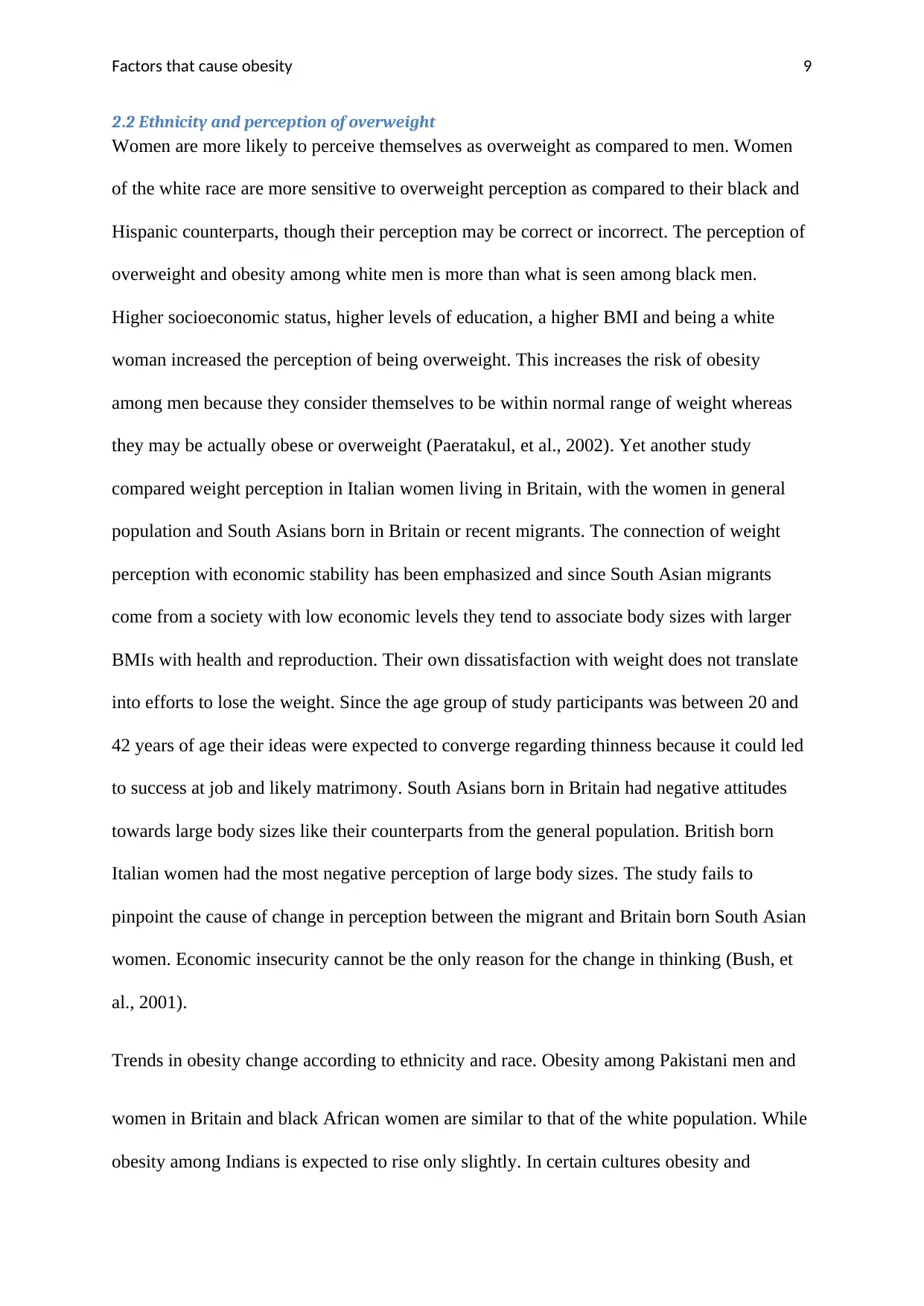
Factors that cause obesity 9
2.2 Ethnicity and perception of overweight
Women are more likely to perceive themselves as overweight as compared to men. Women
of the white race are more sensitive to overweight perception as compared to their black and
Hispanic counterparts, though their perception may be correct or incorrect. The perception of
overweight and obesity among white men is more than what is seen among black men.
Higher socioeconomic status, higher levels of education, a higher BMI and being a white
woman increased the perception of being overweight. This increases the risk of obesity
among men because they consider themselves to be within normal range of weight whereas
they may be actually obese or overweight (Paeratakul, et al., 2002). Yet another study
compared weight perception in Italian women living in Britain, with the women in general
population and South Asians born in Britain or recent migrants. The connection of weight
perception with economic stability has been emphasized and since South Asian migrants
come from a society with low economic levels they tend to associate body sizes with larger
BMIs with health and reproduction. Their own dissatisfaction with weight does not translate
into efforts to lose the weight. Since the age group of study participants was between 20 and
42 years of age their ideas were expected to converge regarding thinness because it could led
to success at job and likely matrimony. South Asians born in Britain had negative attitudes
towards large body sizes like their counterparts from the general population. British born
Italian women had the most negative perception of large body sizes. The study fails to
pinpoint the cause of change in perception between the migrant and Britain born South Asian
women. Economic insecurity cannot be the only reason for the change in thinking (Bush, et
al., 2001).
Trends in obesity change according to ethnicity and race. Obesity among Pakistani men and
women in Britain and black African women are similar to that of the white population. While
obesity among Indians is expected to rise only slightly. In certain cultures obesity and
2.2 Ethnicity and perception of overweight
Women are more likely to perceive themselves as overweight as compared to men. Women
of the white race are more sensitive to overweight perception as compared to their black and
Hispanic counterparts, though their perception may be correct or incorrect. The perception of
overweight and obesity among white men is more than what is seen among black men.
Higher socioeconomic status, higher levels of education, a higher BMI and being a white
woman increased the perception of being overweight. This increases the risk of obesity
among men because they consider themselves to be within normal range of weight whereas
they may be actually obese or overweight (Paeratakul, et al., 2002). Yet another study
compared weight perception in Italian women living in Britain, with the women in general
population and South Asians born in Britain or recent migrants. The connection of weight
perception with economic stability has been emphasized and since South Asian migrants
come from a society with low economic levels they tend to associate body sizes with larger
BMIs with health and reproduction. Their own dissatisfaction with weight does not translate
into efforts to lose the weight. Since the age group of study participants was between 20 and
42 years of age their ideas were expected to converge regarding thinness because it could led
to success at job and likely matrimony. South Asians born in Britain had negative attitudes
towards large body sizes like their counterparts from the general population. British born
Italian women had the most negative perception of large body sizes. The study fails to
pinpoint the cause of change in perception between the migrant and Britain born South Asian
women. Economic insecurity cannot be the only reason for the change in thinking (Bush, et
al., 2001).
Trends in obesity change according to ethnicity and race. Obesity among Pakistani men and
women in Britain and black African women are similar to that of the white population. While
obesity among Indians is expected to rise only slightly. In certain cultures obesity and
⊘ This is a preview!⊘
Do you want full access?
Subscribe today to unlock all pages.

Trusted by 1+ million students worldwide
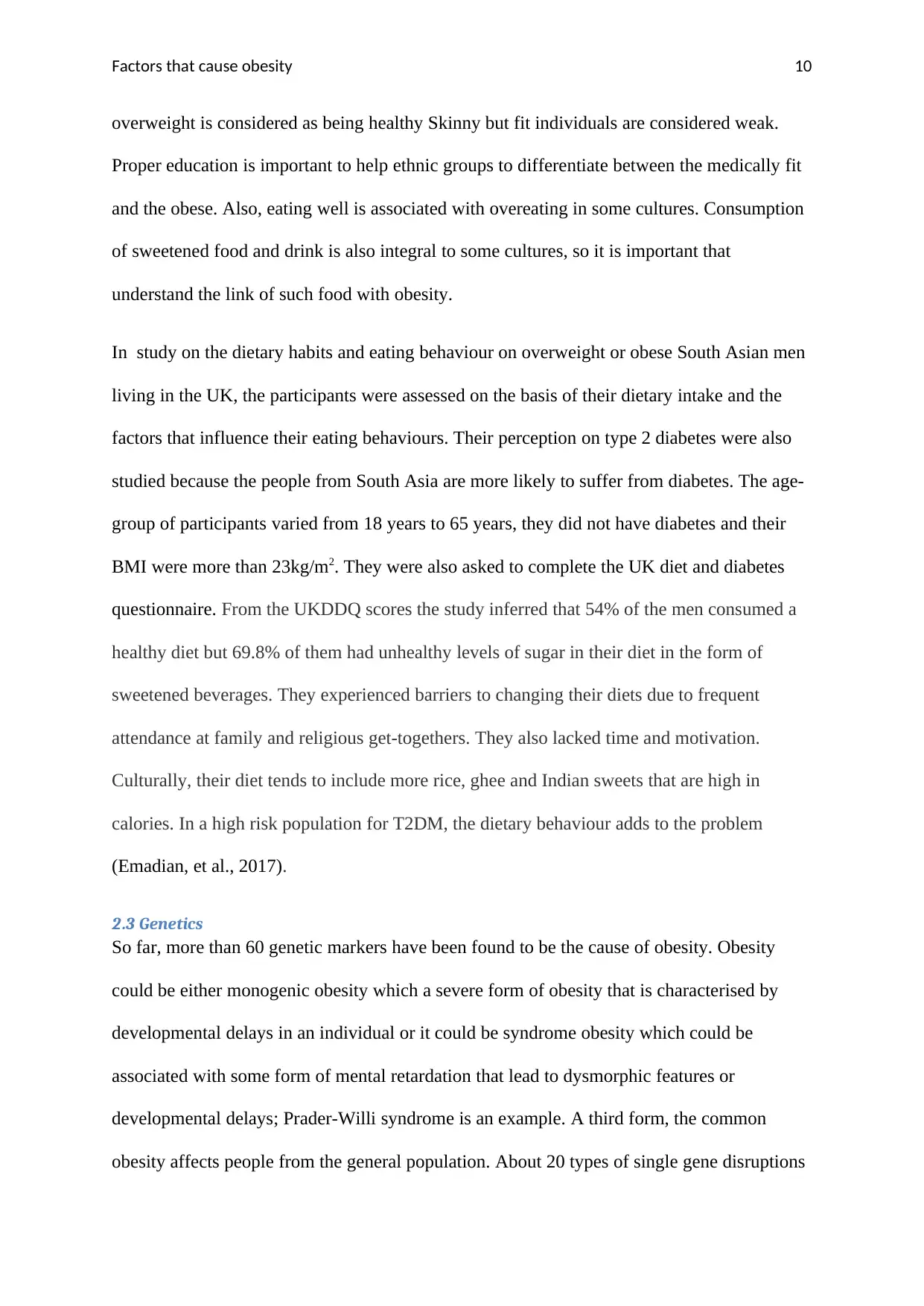
Factors that cause obesity 10
overweight is considered as being healthy Skinny but fit individuals are considered weak.
Proper education is important to help ethnic groups to differentiate between the medically fit
and the obese. Also, eating well is associated with overeating in some cultures. Consumption
of sweetened food and drink is also integral to some cultures, so it is important that
understand the link of such food with obesity.
In study on the dietary habits and eating behaviour on overweight or obese South Asian men
living in the UK, the participants were assessed on the basis of their dietary intake and the
factors that influence their eating behaviours. Their perception on type 2 diabetes were also
studied because the people from South Asia are more likely to suffer from diabetes. The age-
group of participants varied from 18 years to 65 years, they did not have diabetes and their
BMI were more than 23kg/m2. They were also asked to complete the UK diet and diabetes
questionnaire. From the UKDDQ scores the study inferred that 54% of the men consumed a
healthy diet but 69.8% of them had unhealthy levels of sugar in their diet in the form of
sweetened beverages. They experienced barriers to changing their diets due to frequent
attendance at family and religious get-togethers. They also lacked time and motivation.
Culturally, their diet tends to include more rice, ghee and Indian sweets that are high in
calories. In a high risk population for T2DM, the dietary behaviour adds to the problem
(Emadian, et al., 2017).
2.3 Genetics
So far, more than 60 genetic markers have been found to be the cause of obesity. Obesity
could be either monogenic obesity which a severe form of obesity that is characterised by
developmental delays in an individual or it could be syndrome obesity which could be
associated with some form of mental retardation that lead to dysmorphic features or
developmental delays; Prader-Willi syndrome is an example. A third form, the common
obesity affects people from the general population. About 20 types of single gene disruptions
overweight is considered as being healthy Skinny but fit individuals are considered weak.
Proper education is important to help ethnic groups to differentiate between the medically fit
and the obese. Also, eating well is associated with overeating in some cultures. Consumption
of sweetened food and drink is also integral to some cultures, so it is important that
understand the link of such food with obesity.
In study on the dietary habits and eating behaviour on overweight or obese South Asian men
living in the UK, the participants were assessed on the basis of their dietary intake and the
factors that influence their eating behaviours. Their perception on type 2 diabetes were also
studied because the people from South Asia are more likely to suffer from diabetes. The age-
group of participants varied from 18 years to 65 years, they did not have diabetes and their
BMI were more than 23kg/m2. They were also asked to complete the UK diet and diabetes
questionnaire. From the UKDDQ scores the study inferred that 54% of the men consumed a
healthy diet but 69.8% of them had unhealthy levels of sugar in their diet in the form of
sweetened beverages. They experienced barriers to changing their diets due to frequent
attendance at family and religious get-togethers. They also lacked time and motivation.
Culturally, their diet tends to include more rice, ghee and Indian sweets that are high in
calories. In a high risk population for T2DM, the dietary behaviour adds to the problem
(Emadian, et al., 2017).
2.3 Genetics
So far, more than 60 genetic markers have been found to be the cause of obesity. Obesity
could be either monogenic obesity which a severe form of obesity that is characterised by
developmental delays in an individual or it could be syndrome obesity which could be
associated with some form of mental retardation that lead to dysmorphic features or
developmental delays; Prader-Willi syndrome is an example. A third form, the common
obesity affects people from the general population. About 20 types of single gene disruptions
Paraphrase This Document
Need a fresh take? Get an instant paraphrase of this document with our AI Paraphraser
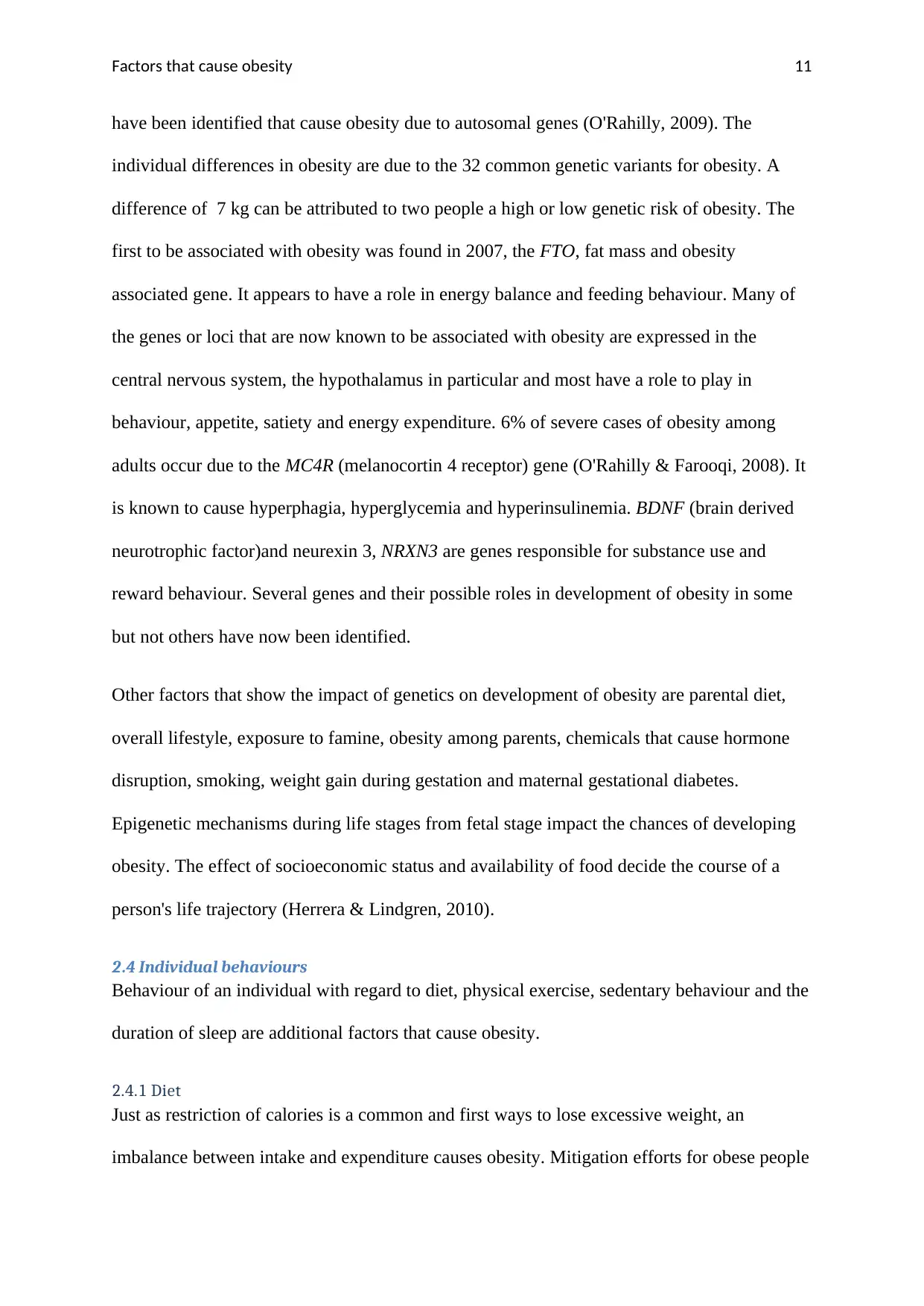
Factors that cause obesity 11
have been identified that cause obesity due to autosomal genes (O'Rahilly, 2009). The
individual differences in obesity are due to the 32 common genetic variants for obesity. A
difference of 7 kg can be attributed to two people a high or low genetic risk of obesity. The
first to be associated with obesity was found in 2007, the FTO, fat mass and obesity
associated gene. It appears to have a role in energy balance and feeding behaviour. Many of
the genes or loci that are now known to be associated with obesity are expressed in the
central nervous system, the hypothalamus in particular and most have a role to play in
behaviour, appetite, satiety and energy expenditure. 6% of severe cases of obesity among
adults occur due to the MC4R (melanocortin 4 receptor) gene (O'Rahilly & Farooqi, 2008). It
is known to cause hyperphagia, hyperglycemia and hyperinsulinemia. BDNF (brain derived
neurotrophic factor)and neurexin 3, NRXN3 are genes responsible for substance use and
reward behaviour. Several genes and their possible roles in development of obesity in some
but not others have now been identified.
Other factors that show the impact of genetics on development of obesity are parental diet,
overall lifestyle, exposure to famine, obesity among parents, chemicals that cause hormone
disruption, smoking, weight gain during gestation and maternal gestational diabetes.
Epigenetic mechanisms during life stages from fetal stage impact the chances of developing
obesity. The effect of socioeconomic status and availability of food decide the course of a
person's life trajectory (Herrera & Lindgren, 2010).
2.4 Individual behaviours
Behaviour of an individual with regard to diet, physical exercise, sedentary behaviour and the
duration of sleep are additional factors that cause obesity.
2.4.1 Diet
Just as restriction of calories is a common and first ways to lose excessive weight, an
imbalance between intake and expenditure causes obesity. Mitigation efforts for obese people
have been identified that cause obesity due to autosomal genes (O'Rahilly, 2009). The
individual differences in obesity are due to the 32 common genetic variants for obesity. A
difference of 7 kg can be attributed to two people a high or low genetic risk of obesity. The
first to be associated with obesity was found in 2007, the FTO, fat mass and obesity
associated gene. It appears to have a role in energy balance and feeding behaviour. Many of
the genes or loci that are now known to be associated with obesity are expressed in the
central nervous system, the hypothalamus in particular and most have a role to play in
behaviour, appetite, satiety and energy expenditure. 6% of severe cases of obesity among
adults occur due to the MC4R (melanocortin 4 receptor) gene (O'Rahilly & Farooqi, 2008). It
is known to cause hyperphagia, hyperglycemia and hyperinsulinemia. BDNF (brain derived
neurotrophic factor)and neurexin 3, NRXN3 are genes responsible for substance use and
reward behaviour. Several genes and their possible roles in development of obesity in some
but not others have now been identified.
Other factors that show the impact of genetics on development of obesity are parental diet,
overall lifestyle, exposure to famine, obesity among parents, chemicals that cause hormone
disruption, smoking, weight gain during gestation and maternal gestational diabetes.
Epigenetic mechanisms during life stages from fetal stage impact the chances of developing
obesity. The effect of socioeconomic status and availability of food decide the course of a
person's life trajectory (Herrera & Lindgren, 2010).
2.4 Individual behaviours
Behaviour of an individual with regard to diet, physical exercise, sedentary behaviour and the
duration of sleep are additional factors that cause obesity.
2.4.1 Diet
Just as restriction of calories is a common and first ways to lose excessive weight, an
imbalance between intake and expenditure causes obesity. Mitigation efforts for obese people
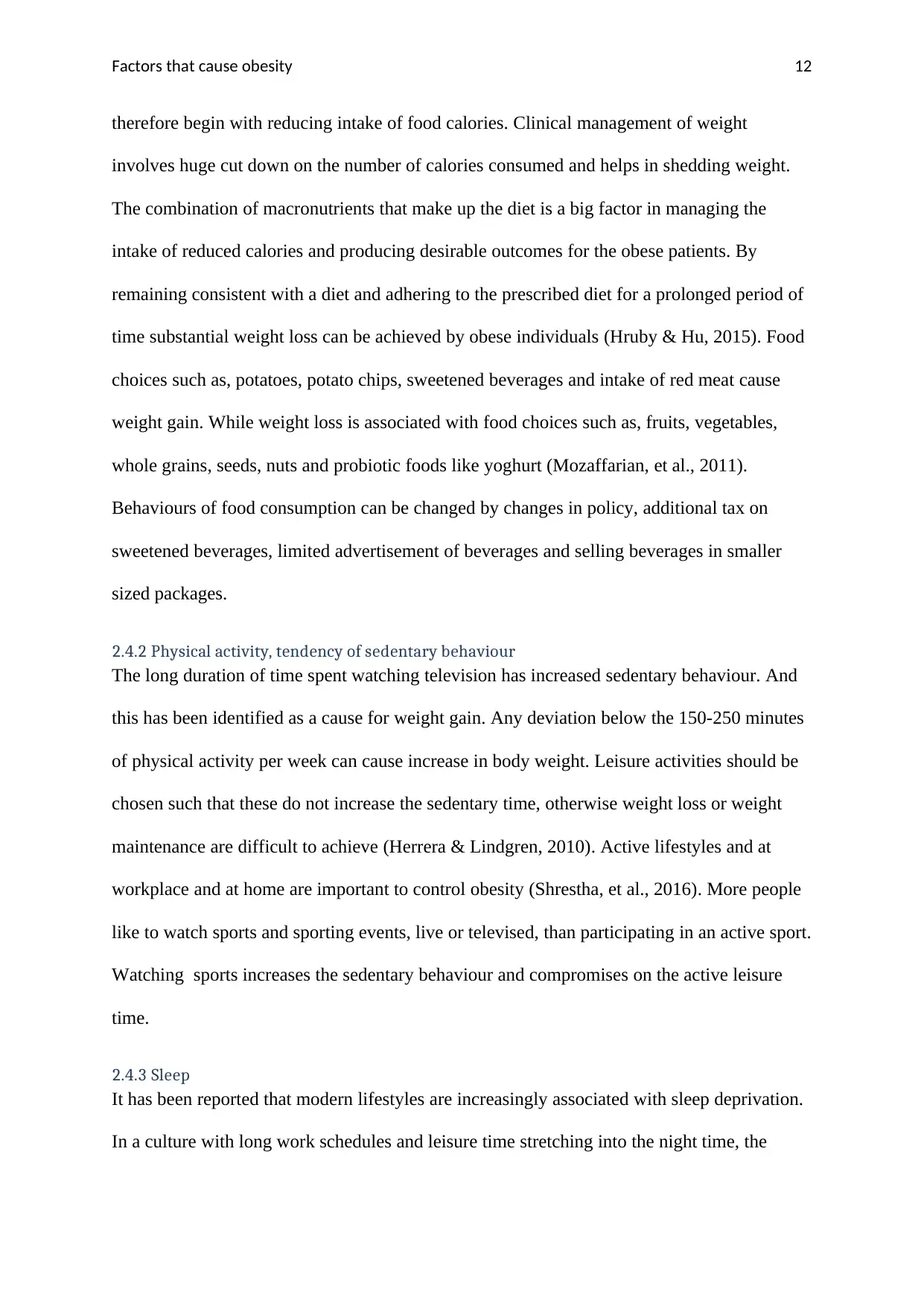
Factors that cause obesity 12
therefore begin with reducing intake of food calories. Clinical management of weight
involves huge cut down on the number of calories consumed and helps in shedding weight.
The combination of macronutrients that make up the diet is a big factor in managing the
intake of reduced calories and producing desirable outcomes for the obese patients. By
remaining consistent with a diet and adhering to the prescribed diet for a prolonged period of
time substantial weight loss can be achieved by obese individuals (Hruby & Hu, 2015). Food
choices such as, potatoes, potato chips, sweetened beverages and intake of red meat cause
weight gain. While weight loss is associated with food choices such as, fruits, vegetables,
whole grains, seeds, nuts and probiotic foods like yoghurt (Mozaffarian, et al., 2011).
Behaviours of food consumption can be changed by changes in policy, additional tax on
sweetened beverages, limited advertisement of beverages and selling beverages in smaller
sized packages.
2.4.2 Physical activity, tendency of sedentary behaviour
The long duration of time spent watching television has increased sedentary behaviour. And
this has been identified as a cause for weight gain. Any deviation below the 150-250 minutes
of physical activity per week can cause increase in body weight. Leisure activities should be
chosen such that these do not increase the sedentary time, otherwise weight loss or weight
maintenance are difficult to achieve (Herrera & Lindgren, 2010). Active lifestyles and at
workplace and at home are important to control obesity (Shrestha, et al., 2016). More people
like to watch sports and sporting events, live or televised, than participating in an active sport.
Watching sports increases the sedentary behaviour and compromises on the active leisure
time.
2.4.3 Sleep
It has been reported that modern lifestyles are increasingly associated with sleep deprivation.
In a culture with long work schedules and leisure time stretching into the night time, the
therefore begin with reducing intake of food calories. Clinical management of weight
involves huge cut down on the number of calories consumed and helps in shedding weight.
The combination of macronutrients that make up the diet is a big factor in managing the
intake of reduced calories and producing desirable outcomes for the obese patients. By
remaining consistent with a diet and adhering to the prescribed diet for a prolonged period of
time substantial weight loss can be achieved by obese individuals (Hruby & Hu, 2015). Food
choices such as, potatoes, potato chips, sweetened beverages and intake of red meat cause
weight gain. While weight loss is associated with food choices such as, fruits, vegetables,
whole grains, seeds, nuts and probiotic foods like yoghurt (Mozaffarian, et al., 2011).
Behaviours of food consumption can be changed by changes in policy, additional tax on
sweetened beverages, limited advertisement of beverages and selling beverages in smaller
sized packages.
2.4.2 Physical activity, tendency of sedentary behaviour
The long duration of time spent watching television has increased sedentary behaviour. And
this has been identified as a cause for weight gain. Any deviation below the 150-250 minutes
of physical activity per week can cause increase in body weight. Leisure activities should be
chosen such that these do not increase the sedentary time, otherwise weight loss or weight
maintenance are difficult to achieve (Herrera & Lindgren, 2010). Active lifestyles and at
workplace and at home are important to control obesity (Shrestha, et al., 2016). More people
like to watch sports and sporting events, live or televised, than participating in an active sport.
Watching sports increases the sedentary behaviour and compromises on the active leisure
time.
2.4.3 Sleep
It has been reported that modern lifestyles are increasingly associated with sleep deprivation.
In a culture with long work schedules and leisure time stretching into the night time, the
⊘ This is a preview!⊘
Do you want full access?
Subscribe today to unlock all pages.

Trusted by 1+ million students worldwide
1 out of 41
Related Documents
Your All-in-One AI-Powered Toolkit for Academic Success.
+13062052269
info@desklib.com
Available 24*7 on WhatsApp / Email
![[object Object]](/_next/static/media/star-bottom.7253800d.svg)
Unlock your academic potential
Copyright © 2020–2026 A2Z Services. All Rights Reserved. Developed and managed by ZUCOL.





